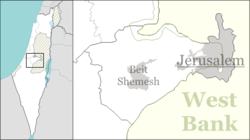Ksalon
Ksalon
| |
|---|---|
| Hebrew transcription(s) | |
| • official | Kesalon |
 | |
| Coordinates: 31°46′26.04″N 35°2′57.83″E / 31.7739000°N 35.0493972°E | |
| Country | Israel |
| District | Jerusalem |
| Council | Mateh Yehuda |
| Affiliation | Agricultural Union |
| Founded | 1952 |
| Founded by | Yemenite Jews |
| Population (2022)[1] | 492 |
Ksalon (Template:Lang-he-n) is a moshav in central Israel. Located near Beit Shemesh, it falls under the jurisdiction of Mateh Yehuda Regional Council. In 2022 it had a population of 492.[1]
History
The first transit camp (ma'abara) for new immigrants was set up on the lands of what became Ksalon in 1950.[2] New immigrants from Yemen brought to Israel in Operation Magic Carpet were given farmland there, but abandoned the moshav a few years later to join members of the Yemenite community living in Rosh Ha'ayin. Their place was taken by immigrants from Morocco.[3]
The moshav was named for the biblical city of Ksalon mentioned in Joshua 15:10Template:Bibleverse with invalid book,[4][5][6] and is located on land that had belonged to the depopulated Palestinian village of Kasla.[7]
References
- ^ a b "Regional Statistics". Israel Central Bureau of Statistics. Retrieved 21 March 2024.
- ^ The Mass Migration of the 1950s Jewish Agency for Israel
- ^ Bedraggled feathers Haaretz, 6 June 2002
- ^ Carta's Official Guide to Israel and Complete Gazetteer to all Sites in the Holy Land. (3rd edition 1993) Jerusalem, Carta, p.268, ISBN 965-220-186-3
- ^ Yizhaqi, Arie (ed.): Madrich Israel (Israel Guide: An Encyclopedia for the Study of the Land), Vol.9: Judaea, Jerusalem 1980, Keter Press, p.383 (in Hebrew)
- ^ Bitan, Hanna: 1948-1998: Fifty Years of 'Hityashvut': Atlas of Names of Settlements in Israel, Jerusalem 1999, Carta, p.31, ISBN 965-220-423-4 (in Hebrew)
- ^ Khalidi, Walid (1992). All That Remains: The Palestinian Villages Occupied and Depopulated by Israel in 1948. Washington D.C.: Institute for Palestine Studies. p. 299. ISBN 0-88728-224-5.

